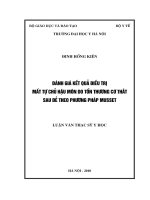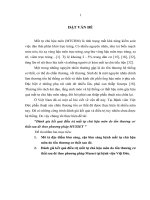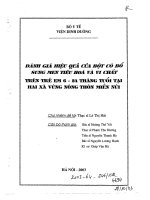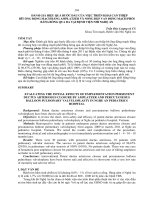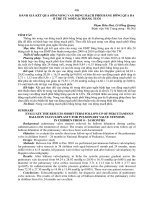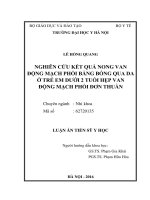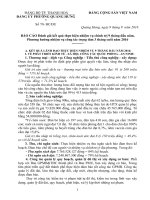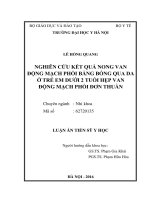ĐÁNH GIÁ kết QUẢ sớm NONG VAN ĐỘNG MẠCH PHỔI BẰNG BÓNG QUA DA ở TRẺ từ 0 đến 24 THÁNG TUỔI
Bạn đang xem bản rút gọn của tài liệu. Xem và tải ngay bản đầy đủ của tài liệu tại đây (565.49 KB, 5 trang )
408
T QU SNG MCH PHI BNG BÓNG QUA DA
TR T N 24 THÁNG TUI
Phm Hu Hoà, Lê Hng Quang
Bnh vi- Hà Ni
:
:
:
:
:
:
SUMMARY
EVALUATE THE RESULTS SHORT TERM FOLLOW-UP OF PERCUTANEOUS
BALLOON VALVULOPLASTY FOR PULMONARY VALVE STENOSIS
IN CHIDREN FROM 0 24 MONTHS
Background: pulmonary valve stenosis relieved by balloon dilatation during cardiac
catheterisation is the treatment of choice. The results of immediate and short term follow-up of
balloon dilatation of the pulmonary valve have been well documented.
Objective: to evaluate the results short term follow-up of balloon dilatation of the pulmonary
valve in children from 0 24 months in National Hospital of Pediatrics, Vietnam.
Design: Prospective study
Methods: Between Jan 2009 to Dec 2010 we performed percutaneous balloon valvuloplasty
for pulmonary valve stenosis in 38 children with aged between 0 month and 24 months, mean
(±SD) 8.84 ± 6.15 months.All patients were follow-up before and after balloon valvuloplasty by
Doppler echocardigraphy.
Results: After balloon valvuloplasty, in Echo the systolic pressure gradient across the
pulmonary vale decresed from 84.24 ± 28.92 mmHg to 20.50 ± 16.35 mmHg (p<0.001) and the
diameter of the pulmonary valve orifice increased from 3.71 ± 1.12 mm to 8.56 ± 2.77 mm
(p<0.05). In catheterization the systolic pressure gradient across the pulmonary vale decresed
from 72.55 ± 27.30 mmHg to 14.68 ± 11.48 mmHg (p<0.001). There was one patient restenosis.
Conclusions: Echocardiographic is usefully for diagnosis and classification of pulmonary
valve stenosis. The results of short term follow-up of balloon dilatation of the pulmanary valve
in children from 0 to 24 months are excellent.
409
-
-
ng nghiên cu
-
oán
và 2010.
Tiêu chun chSiêu âm tim Doppler có hn khi có chênh áp
tâm thu t bu dc kèm theo.
u
-
410
0
5
10
15
20
25
30
35
40
0-1 tháng 2-6 tháng 7-12 tháng 13-24tháng
Tỷ lệ %
có chênh áp
kính vò
20,50 ±
16,35mmHg sau nong van (p <0,001).
0
10
20
30
40
50
60
70
80
90
Siêu âm trước Siiêu âm sau
Giá trị trung bình mmHg
0
10
20
30
40
50
60
70
80
Thông tim trước Thông tim sau
Giá trị trung bình mmHg
catheter là 11,6%.
411
thông tim chúng tôi không
0
10
20
30
40
50
60
Siêu âm trước Siiêu âm sau
Giá trị trung bình mmHg
].
thông tim [5, 8].
là do á
412
30mmHg.
1. Beekman RH, rocchini AP, Rosenthal A (1989), Therapeuric cardiac catheterization for
pulmonary valve and pulmonary artery stenosis, Cardiol Clin, 7:331-340
2. Kan JS, White RIJ, Jitchell SE, Gardner TJ (1982), Percutaneuos balloon valvuloplasty:
A new method for treating congenital pulmonary valve stenosis, N Engl J Med, 307 -540
3. Lawrence AL, Lourdes RP (2001), Pulmonary stenosis. Heart Disease In Infants,
Children, And Adolescents, 820-844
4. McCrindle B, Kan J (1991), Long-term results after balloon pulmonary valvuloplasty,
Circulation, 83:1915-1922
5. -
Percutaneous balloon valvuloplasty for the treatment of pulmonary valve stenosis in
children a single centre experience, Kardiol Pol, 67: 369-375
6. Rao PS, Galal O, Patnana M, Buck H, Wilson AD (1998), Results of three to 10 years
follow up of balloon dilatation of the pulmonary valve, Heart, 80:591-595
7. Raymond T, Fedderly MD, Robert TH, Beekman MD (1995), Balloon valvuloplasty for
pulmonary valve stenosis, Journal of Interventional Cardiology, 8:451- 461
8. Tabatabaei H, Boutin C, Nykanen DG (1996), Morphologic and hemodynamic
consequences after percutaneous balloon valvotomy for neonatal pulmonary stenosis:
medium-term follow-up, J Am Coll Cardiol, 27:473-8
